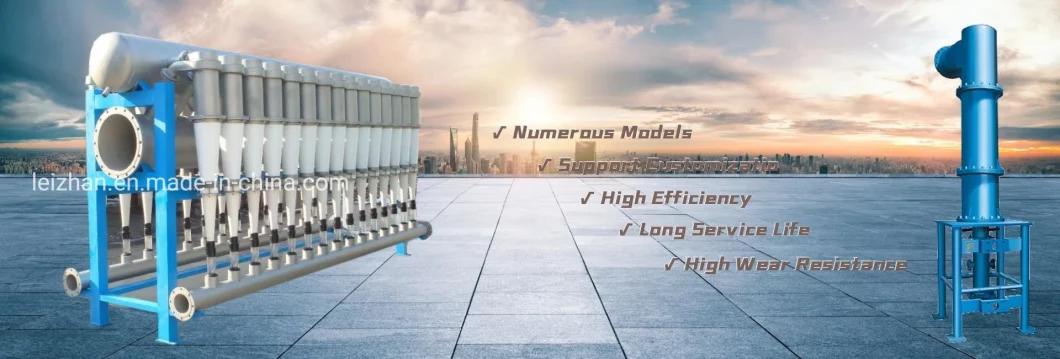
The cleaner is a device that uses the centrifugal principle to remove impurities with a different density in the slurry. The upper part of the cleaner is made of stainless steel, and the lower part is injection molded of polyurethane material. The inner wall of the main body is a spiral cone design.
The cleaner can be used in various slurry purification systems, mainly to remove heavy impurities such as sand and iron filings in the slurry with a density greater than the slurry (heavy slag remover) and mixed stickies and paraffins with a density less than the slurry , Hot melt glue, plastic sheet, foam, gas, ink particles and other light impurities (lightweight cleaner).
The high-concentration cleaner is an ideal equipment used to remove various heavy impurities such as metals and sand in the pulp at a higher concentration to obtain high-quality pulp. It is also an essential equipment for the purification of waste paper pulp.

The high-concentration cleaner uses the difference in the proportion of fiber and impurities to separate impurities. The slurry enters the slag remover from the feed three-way tangent line at a certain pressure, and then rotates at a high speed. Due to the difference of centrifugal force, the heavy impurities are thrown to the wall of the vessel. Under the action of gravity, it gradually moves to the bottom of the cone and enters the slag tank. Due to the small centrifugal force, the fiber gradually travels to the central low pressure area, vortexes up after reaching the bottom, and is finally discharged from the good slurry outlet. The cone of the high-concentration cleaner has a certain taper, and the cone is longer, and the radius of rotation of the slurry in the cone is gradually reduced to prevent the speed of the slurry from being reduced during the rotation, and to ensure that the centrifugal force is strengthened, thus improving the paper stock Purification efficiency. The balance water pressure at the bottom is slightly greater than the slurry pressure, so that the fibers cannot enter the slag tank. Only sand, metal particles, rubber blocks, plastics and other heavy impurities sink into the tank, reducing fiber loss.
Working principle: Separate waste impurities from fibers by centrifugal force.
When the pulp enters the top of the slag remover from the tangential direction, the slurry flow produces a vortex movement, which accelerates downward along the cone of the slag remover in a spiral shape. The movement of the vortex generates centrifugal force, which causes the impurities heavier than water to move to the inner wall of the slag remover, while those with a relative density less than water move to the core of the vortex.
Model | LZC-2 | LZC-3 | LZC-4 | LZC-5 | LZC-6 | LZC-7 |
Capacity: t/d | 25-45 | 60-85 | 90-120 | 120-160 | 160-200 | 230-380 |
Consistency: % | 0.40-5 |
Inlet Pressure (Mpa) | 0.15-0.40 |
Outlet Pressure (Mpa) | 0.1-0.25 |
Recoil water pressure (Mpa) | Inlet pressure plus 0.02 Mpa |
Slagging method | Manual / Automatic / Intermittent / Continuous |


















 The high-concentration cleaner uses the difference in the proportion of fiber and impurities to separate impurities. The slurry enters the slag remover from the feed three-way tangent line at a certain pressure, and then rotates at a high speed. Due to the difference of centrifugal force, the heavy impurities are thrown to the wall of the vessel. Under the action of gravity, it gradually moves to the bottom of the cone and enters the slag tank. Due to the small centrifugal force, the fiber gradually travels to the central low pressure area, vortexes up after reaching the bottom, and is finally discharged from the good slurry outlet. The cone of the high-concentration cleaner has a certain taper, and the cone is longer, and the radius of rotation of the slurry in the cone is gradually reduced to prevent the speed of the slurry from being reduced during the rotation, and to ensure that the centrifugal force is strengthened, thus improving the paper stock Purification efficiency. The balance water pressure at the bottom is slightly greater than the slurry pressure, so that the fibers cannot enter the slag tank. Only sand, metal particles, rubber blocks, plastics and other heavy impurities sink into the tank, reducing fiber loss.
The high-concentration cleaner uses the difference in the proportion of fiber and impurities to separate impurities. The slurry enters the slag remover from the feed three-way tangent line at a certain pressure, and then rotates at a high speed. Due to the difference of centrifugal force, the heavy impurities are thrown to the wall of the vessel. Under the action of gravity, it gradually moves to the bottom of the cone and enters the slag tank. Due to the small centrifugal force, the fiber gradually travels to the central low pressure area, vortexes up after reaching the bottom, and is finally discharged from the good slurry outlet. The cone of the high-concentration cleaner has a certain taper, and the cone is longer, and the radius of rotation of the slurry in the cone is gradually reduced to prevent the speed of the slurry from being reduced during the rotation, and to ensure that the centrifugal force is strengthened, thus improving the paper stock Purification efficiency. The balance water pressure at the bottom is slightly greater than the slurry pressure, so that the fibers cannot enter the slag tank. Only sand, metal particles, rubber blocks, plastics and other heavy impurities sink into the tank, reducing fiber loss. 



